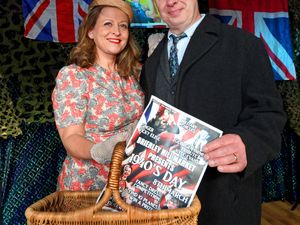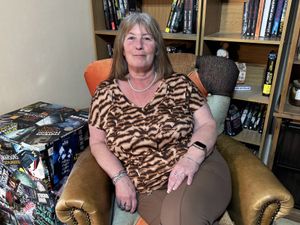Bats out of hell? No, they’re lovely
Think bats are just for Halloween? Think again. We meet the people passionate about the nocturnal beast. . .
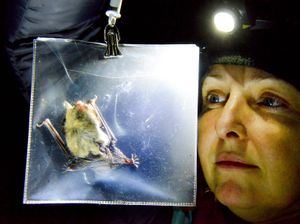
These black, winged creatures that fly through the night sky have long been associated with Halloween.
But there’s so much more to these fascinating and much-needed insect-eaters and pollinators than many of us may realise.
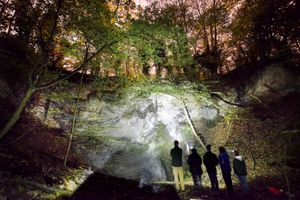
Bats are often described as one of nature’s most misunderstood animals yet they play an important role in different environments around the world.
They are also one of our least noticed mammals not only because they are nocturnal, but because they also hibernate through the cold winter months.
There are 18 species of resident bat in the UK – the largest being the Noctule, which weighs around 28g, and the smallest being the tiny Pipistrelle which tips the scales at up to 8g.
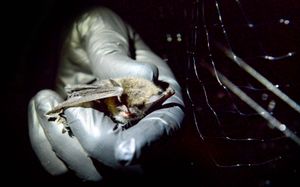
And here in the Midlands we are very lucky to have many different species swarming and breeding across the region including some of the country’s rarest.
One of the area’s bat hot spots is a disused limestone mine within the grounds of Dudley Zoo where a team of conservationists have been hanging out to learn more about them.
Known as Big Ben Cavern because it’s as deep as the famous clock is tall, experts have discovered it’s one of the most populated areas in the region for the creatures.
For the past two years, a conservation and monitoring project has been taking place at the site which is believed to be used by hundreds of bats.
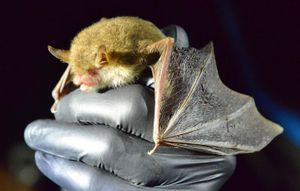
The zoo’s conservation officer Chris Leeson has been working alongside skilled volunteers from the Birmingham and Black Country Bat Group, also known as BrumBats.
Chris, who took up the role in 2016, contacted the group after learning about the zoo’s resident bats from old records of the last known survey that took place 15 years earlier.
“I was looking through some old information on the zoo and discovered we had bats, I didn’t know they were there.
“I got in touch with Brum Bats and they got a team together and brought them to the zoo,” he says.
The group has a special licence from National England, which enables to carry out monitoring and research work with the bats.

They humanely catch and release the bats to record the different species and sex using special harp traps’ and mist nets’.
Harp traps are designed to catch flying bats without damaging their wings and they fall into a soft canvas bag.
Mist nets can be virtually invisible and contain small pockets for the creatures to drop in to unharmed.
The surveys at the zoo take place eight times a year – four times in spring and four in autumn – to see what species we have on site and to assess the health of the population.
Monitoring has to be undertaken at night, when the bats are active so the team don red light head torches.
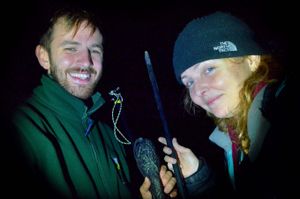
The conservationists catch the bats and then measure their wings and clip their hair so they know if they come across the same bats again.
If the bats cooperate, they will also collect a DNA sample. By listening to various sound frequencies they can determine the species.
Nine different species have been discovered roosting in the old mine including the Brown Long-eared bat, the Daubenton’s bat and the Natterer’s bat , Chris tells us.
The brown long-eared bat has ears that are nearly as long as its body and as well hunting airborne insects, it also flies slowly through foliage, picking insects directly from leaves.
While the the Daubenton’s bat forages for small flies, such as midges, caddisflies and mayflies, just above water.
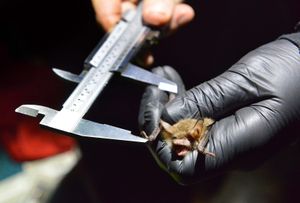
Although the Natterer’s bat can be found across the UK, it’s a scarce species and it prefers to forage low down among trees.
The other species of bat found in Big Ben Cavern are the Lesser Horseshoe, Common Pipistrelle, Soprano Pipistrelle, Whiskered, Leisler’s and Noctule.
“It’s pretty unheard of to have nine species in an urban area. Once we catch a bat, we bring it back for processing. We determined the age by looking at their ‘bits’ as we can tell how long it’s been breeding. We’ve got a good mixture of ages. We measure the forearm part of the wing and we weigh them.
“We trim a bit of the hair on their shoulders so we can tell if it’s the same bat going into the net because we don’t want to recapture the same ones.
“We haven’t had recaptured any yet which is a good sign as it shows there are a lot of them,” says Chris, who presented their research to the British & Irish Association of Zoo & Aquariums annual conference and general meeting in June.
“A lot of people see Birmingham and the Black Country as an industrial heartland with not much wildlife. But if you take a look in these old industrial sites, like the old mines, you will find they have become a haven for wildlife,” he adds.

Ecologist Morgan Hughes, who is chairman of Brumbats, is studying the movements of Bats in Green Belt for her PhD in Animal Behaviour and Wildlife Conservation.
“The site at Dudley is a general site used by a wide variety of species. It help us to learn important information about the different types of species, their numbers and their habitats.
“We’ve also found out that the site is an important swarming site for Natterer’s bats and the cave system is important to hibernating bats,” she says.
The survey team also records information such as the characteristic features of each species the trail of golden bristles found along the edge of a Natterer’s bat’s tail.
Brumbats was first established in 1986 and relaunched in 2006. Members work to record, promote and protect bats and are currently working on producing an atlas of the bats of Birmingham and the Black Country.
This will include maps showing the distribution of the different species across the area.
It’s hoped that it will be a vital resource for landowners, developers and other organisations an ensure bats get the protection they need.
“We need to know what areas are important for bats for conservation and what areas need protection,” says Morgan, who grew up in south Florida.
BrumBats is currently carrying out the Urban Bat Project which seen surveys take place at almost 20 sites across the region, including the one at Dudley Zoo, during the past two years carried out by a core group of 15 members.
They include a former limestone mine in the privately-owned Linley Woods in Walsall and Sutton Park in Sutton Coldfield.
All the data they compile is sent to EcoRecord, which is the Local Environmental Record Centre for Birmingham and the Black Country.
It collects, collates and makes available information about the wildlife and habitats in the area and currently has more than 500,000 species records on its database.
All bat species, their breeding sites and resting places are fully protected by law and Morgan says it’s important that as much data as possible is collected to ensure they aren’t disturbed or their habitats damaged
“If someone puts in a planning application, they will have to consider bats. If these records are there will now where they roost and the important sites that are key to their survival.The law protects their breeding and roosting sites but not their foraging and community routes so the more that’s known about these the better to we can help to protect them.
“Landowners and managers will be able to use this information to help with habitant management like not felling a tree with woodpecker holes as bats will roost in the holes and not over-pruning trees,” explains Morgan, who has been with Brumbats since 2004.
Her love of bats comes from her growing up with them roosting in the roof of her home in Florida. “I’ve always been fascinated by them.
“The fact we don’t know much about them is a big thing for me. I’m interested in any genus or species that is under-recorded,” says Morgan.
“I really love Leisler’s bats – they are my favourite. I’m not quite sure what it is about them. They are one of the rarest bats that we catch, but we do pick them up on bat detectors so I am hoping we find more as we take the project forward,” she adds.
There are a lot of myths surrounding bats, which can cause people to think they are something to be afraid of. Common misconceptions are stuff like bats being blind – they can see about as well as we do, which, at night, is admittedly not that brilliantly.
“I think when people se a bat up close for the first time they expect them to be scaly and weird, not furry and cute, so most people are pleasantly surprised,” says Morgan.
Chris,a wildlife conservation graduate from the University of Kent, who is now studying for his masters in wildlife conservation at the University of Wolverhampton, also finds these creatures very intriguing.
“They are so misunderstood and there is so much to still find out about them.
“They’ve been here at the zoo for all these years but no one has really looked for them before.
“People think they are these horrible creatures that come out for Halloween but they really are beautiful and they’ve got such sweet faces. They really are stunning.” l For more information about the Birmingham and Black Country Bat Group see brumbats.wordpress.com


